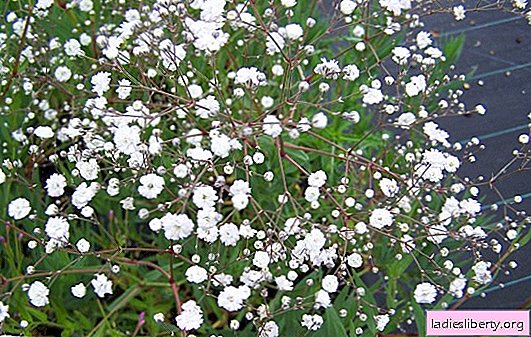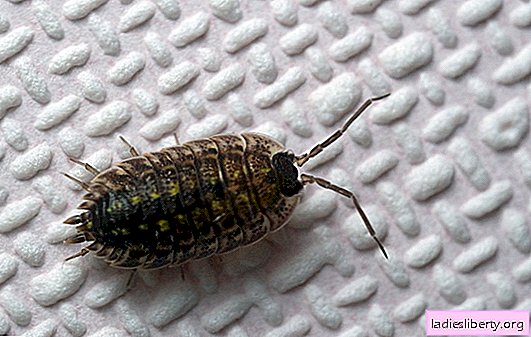
A weightless cloud of air looks like a gypsophila plant or a gypsum lover planted in the garden.
It got its name because it prefers to grow on gypsum soils.
For the spherical shape of the bush, it is also called the "tumbleweed", and for the openwork of the flower cap - "the breath of a child" or the "veil of the bride."
This plant belongs to the clove family.
Depending on the variety, it reaches a height of 0.2 to 1 meter. In a garden culture, 3 types of gypsophila are grown:
• panicled - This is a giant among gypsophila (can grow up to 1.2 m in height and up to 1 m in the diameter of the bush). It blooms with white or pink flowers 5-8 mm in diameter. Flowering is long: from June to mid-September. Highly resistant to frost, drought. Looks good in group cultivation, in mix beds with large flowering plants, used for cutting into bouquets and home decor;
• creeping - dwarf gypsophila (sometimes 0.1-0.2 m high). The diameter of the bush reaches up to 0.5m. It blooms in the first half of summer with small flowers of white or pink. It is used as a groundcover on stony hills, rockeries, rocky areas. Without winter shelter it can freeze;
• dolphoid - A compact, unpretentious plant, found in the Himalayas at an altitude of up to 5 km. Flowering continues in late May to July. The bush reaches a width of up to 30 cm. This species is planted as a landscape edging of sites, a cover plant of rocky surfaces, lawns.
Thanks to its gentle flower haze with a pleasant aroma, long flowering, and unpretentiousness to the conditions of the hyposophila, this is an excellent background plant for rock gardens, stone slides, sunny areas of the garden.
Gypsophila: landing
As the name implies, gypsophila prefers loose calcareous soils, although it can grow on any soil. Despite its unpretentiousness, we don’t like areas with a close location of groundwater (this leads to its heating up in the spring). In this case, additional drainage of the soil is necessary.
The choice of location also depends on the type of gypsophila and the purpose of its cultivation. For example, a tall panicled gypsum lover will ideally fit into the company of large-flowered plants. For the creeping and stalk-like gypsophila, the best location would be alpine hills, rocky slopes, rockeries.
Gypsophila ganglion-like grows well in rock aria

In any case, we feel good in sunny dry areas, although it can withstand light partial shade.
Gypsophila planting is done according to the scheme: between plants in a row leave 0.7-1 m, and between rows 1.3 m.
On a note: The visible "fragility" of the ground part is compensated by a powerful branched root system, extending deep into the earth to 0.7 m. Therefore, it must be planted immediately in a permanent place.
Gypsophila: growing
Gypsophila can be grown by seeds, cuttings, dividing the bush.
Seeds can be sown directly in the soil or first grow seedlings.
Planting seeds in open ground is carried out in the second half of April-early May (the period depends on the climatic conditions of the region). Shoots appear after 1-2 weeks. After 3 weeks, the seedlings thin out and dive, maintaining a distance of 0.1-0.15 m from each other. In autumn, grown plants are moved to a permanent place (at the rate of 2-3 plants per 1 sq.m.).
To grow seedlings, gypsophila seeds are sown in boxes under glass or film. Before planting, sand, crushed chalk, small pebbles are added to the soil, moistened. Seeds are laid directly on the surface of the earth, sprinkled with sand or a thin layer of substrate. The planting box is left at room temperature. After emergence, the seedlings are dived into separate pots in 2-3 weeks and kept on a well-lit window sill. They are planted in open ground when constant warm weather is established (late April-early May). Young plants tolerate the transplant quite tolerably until their root system has developed inland.
Gypsophila seedlings

For cuttings, young shoots of gypsophila are used. This process is carried out in late May and early June. Cuttings are cut before flowering, cutting the stems into pieces 5-8 cm long. Before planting cuttings under a film or in a greenhouse, they are treated with a root stimulant (for example, heteroauxin). They are planted to a depth of 2 cm. The optimum temperature for successful rooting is +20 degrees. With increased humidity in the greenhouse, cuttings are watered sparingly. Young plants take root about a month after planting. In August, they are transplanted to a permanent place.
Terry forms of gypsophila can be propagated by vaccination. On non-terry species of this plant in spring, a "spread" terry species is grafted.
Gypsophila: care
Gypsophila care is not difficult due to the unpretentiousness of this plant. To make it feel good on your site "at ease" lime is added to the soil for planting (50 g / m2). It is also not forbidden to introduce humus and complex mineral fertilizers in the spring that do not increase the acidity of the soil, although gypsum cultivation is not demanding on this.
Kachim easily tolerates drought, but for abundant flowering, he needs regular watering. In hot weather, young plants are watered every day. Adult bushes should be watered after the soil dries under them. Water is poured directly under the bush, trying to avoid getting wet on the ground part of the plant (this can lead to the development of fungal diseases).
Before flowering around tall species of gypsophila, support should be put in order to support the bush from blocking from its own gravity or wind. After the plant fades, pruning is performed to stimulate the growth of new shoots.
Gypsophila is a frost-resistant plant, but it is better to cover it with dry bark, spruce branches or dry leaves for the winter.
Diseases and pests of gypsophila. Measures to combat them
Gypsophila with excess moisture (prolonged rainy weather, frequent watering) is susceptible to various fungal diseases:
• gray rot caused by fungi of the genus Botridis. In the initial stage, kachima leaves lose their elasticity and turn brown at the edges. As the disease develops, gray spots appear on the affected areas - spore-bearing foci of the mycelium. Such parts of the plant must be removed to prevent the spread of the disease.
• smut is provoked by smut fungi. As a result of their activities, various parts of the plant are destroyed, turning them into a black spore-bearing mass. To combat this disease, it is necessary to observe the agricultural technology of the crop grown, before planting, disinfect the seeds with fungicides (Topaz, Gamair, Fundazol).
• rust - Another common fungal disease of many plants, including gypsophila. Rust is easy to identify: red or yellow pads (pustules) of different sizes and shapes form on the plant.

The manifestation of rust on the leaves When they crack, the contents spill out - an orange powder (spores of a rust fungus). Affected plants lose moisture due to a violation of the photosynthesis process, they lag behind in growth, their winter hardiness decreases.
Measures for the control of fungal diseases of gypsophila consist of regular inspection of plants, compliance with agricultural technology (to prevent over-humidification), weed removal. When the first signs of damage are detected, gypsophila is treated with fungicidal preparations: Abiga Peak, Bordeaux liquid, Oksikhom, vitriol, Topaz, Previkur, etc.
Of the pests on the gypsophila, gall and cyst-forming nematodes often feed on the juice in the roots of the plant. As a result, the growth process is sharply reduced in Kachima, the leaves curl, turn yellow or turn brown. To destroy these pests, the ground under the bushes of gypsophila is shed with such drugs as Tiazon, Bi-58, Rogor in accordance with the instructions for use.











